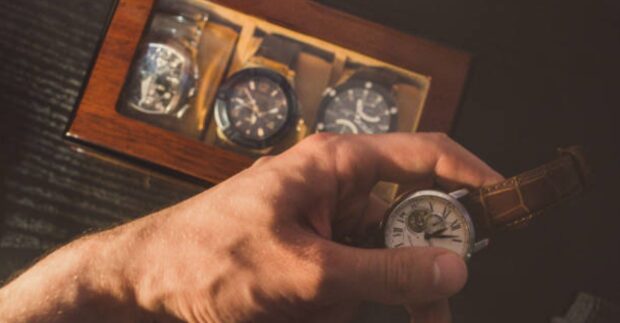How to Choose the Right Watch Winder for Your Collection

A watch winder serves as your timepiece’s silent guardian, maintaining the delicate balance between preservation and accessibility. Unlike simple storage, a quality winder simulates natural wrist movement, keeping your automatic watches wound and ready to wear.
The fundamental principle revolves around perpetual motion. Your automatic watch’s rotor needs consistent, gentle movement to maintain the mainspring’s tension. Without this motion, complications like perpetual calendars, moon phases, and GMT functions reset to zero—requiring tedious manual recalibration.
Modern collectors face a critical decision: which watches deserve winding versus natural rest periods. Contrary to popular belief, not every automatic watch benefits from constant winding. Simple three-hand models often perform better with periodic dormancy, while complex complications demand continuous operation.
Key Factors in Watch Winder Selection
Motor Quality and Noise Levels
The heart of any winder lies in its motor system. Premium units employ Swiss-made or Japanese motors that operate below 15 decibels—whisper-quiet for bedroom placement. Budget alternatives often use loud, vibrating motors that disturb sleep and potentially damage delicate movements through excessive vibration.
Turns Per Day (TPD) Precision
TPD requirements vary dramatically between manufacturers. While most guides suggest 650-900 TPD as universal, this oversimplifies reality. A Patek Philippe Aquanaut requires exactly 800 TPD, while certain Breitling models demand 1,900 TPD. Using incorrect settings can overwind mechanisms, causing premature wear or timing irregularities.
Rotation Direction Capabilities
Bidirectional winding suits 90% of modern automatics, but exceptions exist. Vintage watches often require unidirectional winding to prevent crown mechanism damage. Advanced winders offer clockwise, counterclockwise, and alternating patterns—essential for mixed collections.
Power Source Flexibility
Battery operation provides placement freedom, while AC power ensures consistent performance. The best winders offer dual power options, switching automatically during power outages. This feature proves invaluable for collectors with sensitive complications that lose significant time during power interruptions.
Matching Winders to Your Watch Collection
Single Watch Scenarios
For collectors with one prized automatic, a single-watch winder offers focused care. Choose models with adjustable TPD ranges (300-1,200) to accommodate future acquisitions. The Mozsly watch winder collection exemplifies this approach, offering customizable settings for individual timepieces.
Multi-Watch Considerations
Collections exceeding three watches require careful planning. Modular systems allow expansion without replacing entire units. Consider individual motor control—cheaper multi-watch winders use single motors for all positions, creating uniform settings unsuitable for mixed collections.
Brand-Specific Requirements
Swiss manufactures like Rolex, Omega, and Patek Philippe maintain specific winding tolerances. German brands such as A. Lange & Söhne require different approaches entirely. Research your specific models before purchasing—generic settings risk long-term movement damage.
Technical Considerations and Performance
Intermittent vs. Continuous Operation
Superior winders employ intermittent cycling, mimicking natural wearing patterns. Continuous operation stresses movements unnecessarily and drains power reserves faster. Look for programmable rest periods between winding cycles—typically 30-60 minutes of activity followed by 4-6 hours of rest.
Microprocessor Control Systems
Advanced winders incorporate microprocessor controls for precise timing and memory storage. These systems remember individual watch settings, automatically adjusting when different timepieces are placed in the same position. This technology eliminates guesswork and prevents user error.
Temperature and Humidity Monitoring
Professional-grade winders include environmental sensors, alerting users to conditions that might affect movement accuracy. Extreme temperatures alter lubricant viscosity, while humidity promotes corrosion. These features transform simple winders into comprehensive watch care systems.
Budget vs. Quality: Making Smart Investments
Entry-Level Options ($100-300)
Budget winders suit collectors with simple time-only automatics. Acceptable for occasional use, but expect shorter lifespans and basic functionality. These units work adequately for Tudor, Seiko, and other robust movements that tolerate less precise winding.
Mid-Range Solutions ($300-800)
This category offers the best value for serious collectors. Quality motors, adjustable TPD, and multi-watch capabilities appear at this price point. Suitable for collections including Omega, Breitling, and entry-level Swiss complications.
Premium Investment ($800+)
High end watch winder models justify their cost through superior engineering, whisper-quiet operation, and advanced features. Essential for collectors with Patek Philippe, Vacheron Constantin, or other haute horlogerie pieces requiring precise care.
The price difference reflects component quality, not just brand prestige. Premium units use aerospace-grade materials, Swiss motors, and undergo extensive testing. For valuable collections, this investment protects against costly movement repairs.
Common Mistakes to Avoid
Overwinding Damage
The most costly error involves excessive TPD settings. Overwinding stretches mainsprings beyond design limits, causing permanent damage. Always start with manufacturer recommendations, then adjust gradually while monitoring timekeeping accuracy.
Ignoring Direction Requirements
Assuming all watches accept bidirectional winding can damage vintage pieces. Pre-1960s automatics often require specific rotation directions. Research your specific models before first use—replacement parts for vintage movements are increasingly scarce.
Neglecting Regular Maintenance
Winders require periodic cleaning and lubrication like any mechanical device. Dust accumulation affects motor performance, while worn drive belts create irregular rotation. Schedule annual maintenance to ensure optimal performance.
Choosing Based on Aesthetics Alone
Beautiful wooden cases and luxury finishes mean nothing without proper mechanical function. Prioritize motor quality, TPD accuracy, and programmable features over appearance. A reliable plastic winder outperforms an attractive but poorly engineered luxury model.
Conclusion
Selecting the perfect watch winder requires balancing technical requirements with practical considerations. Focus on your collection’s specific needs rather than impressive specifications. Quality winders protect valuable timepieces while enhancing the ownership experience—making every moment with your watches more enjoyable.
Remember that the best winder serves your collection’s unique requirements, not generic recommendations. Invest in precision, reliability, and features that match your horological passion.

Source: How to Choose the Right Watch Winder for Your Collection



